British musician, audio engineer, and multi-instrumentalist Guy Fletcher has appeared both on stage and in the studio with world-renowned artists such as Tina Turner, Randy Newman, Mick Jagger, Roxy Music, and Mark Knopfler.
In 1984, he joined Dire Straits as one of two keyboard players and performed on their hugely-successful final two studio albums Brothers In Arms (1985) and On Every Street (1991). Following the band’s dissolution in 1995, Fletcher remained in Knopfler’s creative orbit and contributed to his solo albums Golden Heart (1996), Sailing To Philadelphia (2000), The Ragpicker’s Dream (2002), Shangri-La (2004), Kill To Get Crimson (2007), Get Lucky (2009), Tracker (2015), Down The Road Wherever (2018), and One Deep River (2024).
In 2022, Fletcher was tasked with creating brand-new Dolby Atmos mixes of Dire Straits’ Money For Nothing compilation (1988) from the original multitrack tapes. Since then, he’s also completed immersive mixes of Brothers In Arms, One Deep River, as well as his own two releases Anomaly (2022) and High Roads (2019)–both of which are now available as hi-res digital downloads in the IAA shop!
I recently had the chance to chat with Guy about his immersive audio journey, the complexities involved with remixing classic albums, and where he thinks the industry is headed.
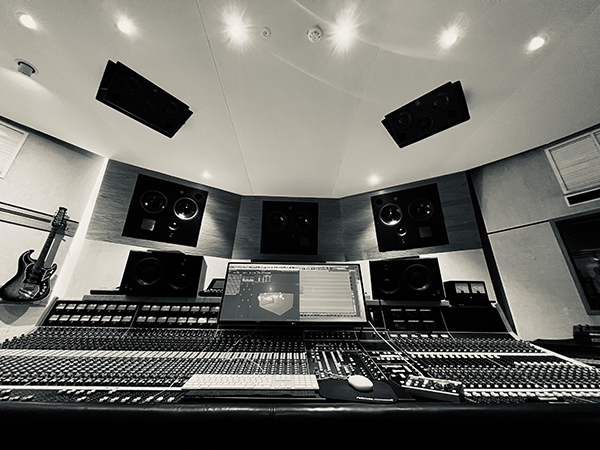
Who introduced you to the concept of mixing music in Dolby Atmos? What do you enjoy about working in the immersive format?
I spend a lot of time working at British Grove–Mark Knoplfer’s studio–and about two years ago, they decided to outfit one of their rooms for Atmos mixing. I was already aware of the format, but that was the moment where I decided to really find out what it was all about. So I got in touch with Myles Clarke at Dolby, and he played me some tracks. Obviously, I loved it straightaway.
Right around this time, I was asked to remix Dire Straits’ Money For Nothing (1988) compilation in Atmos. Since the studio upgrade hadn’t been completed yet, I started working on it at home in binaural mode. A lot of people had recommended that I start in binaural anyway.
By sheer coincidence, my next door neighbor is a guy called Chris Porter who’s also an engineer. He worked on a lot of George Michael’s records, as well as with the Pet Shop Boys. He had just installed an Atmos room at home, so I could go next door and start experimenting with how the binaural was translating. Eventually, the British Grove room was completed and I finished the Atmos mixes there.
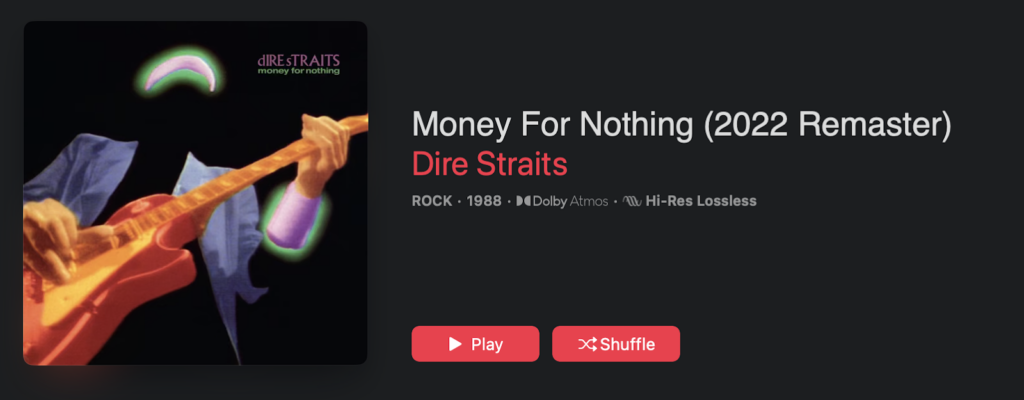
What kind of challenges did you face in remixing these classic Dire Straits songs? Was it difficult to match the feel of the original stereo mixes while also making full use of the immersive medium?
Obviously the main thing you don't want to do is make them sound too different, because these tracks have a lot of emotional value to listeners. So it’s really all about recreating the stereo mix in a more immersive way.
This can be really tricky, especially when you’re dealing with records from the ‘70s or especially the ‘80s because of all the new digital sounds that came about during that decade. Having said that, there are great plugin recreations available of hardware from that era like the harmonizers or old EQs.
The first thing I do is rebuild the stereo mix as closely as I can, without even thinking about Atmos and pulling it apart into the 360-degree environment. The beautiful thing about Atmos is it enables you to hear all the detail in the individual sounds, because there's so much space. That’s one thing I know Mark [Knopfler] is particularly fascinated with, being able to appreciate how well the sounds were recorded without ruining the balance.
Old mixes tend to have a certain amount of compression and limiting, so everything feels glued together. When you pull them apart, they don't always sound that great. You have to find different methods to recreate that effect without bus compression or limiting, and so far I've always managed to find a way.
Chuck Ainlay’s 5.1 surround mix of Brothers In Arms was released way back in 2005, to coincide with the album's 20th anniversary. In remixing that record for Atmos, were you able to repurpose any of what he did back then or did you start completely fresh?
Chuck did a lot of the hard work for me on that album, because he had located the multitrack elements needed to rebuild the album back when he did the 5.1 mix. That said, there were still some missing components that he hadn’t found. So we did have to go back and sift through a lot of archival material from that time, which wasn’t very well-documented. Since I was there back when we recorded the album, I could rely a bit on memory.
Before I mixed Brothers In Arms in Atmos, the first project I did for Dire Straits was the Money For Nothing compilation–which spanned multiple eras of the band. It was kind of a baptism by fire, because there were so many different multitrack formats. There were a couple of songs that were actually missing the lead vocal, and after six months of searching I really thought we weren’t going to find them. It really took some detective work to rebuild those mixes and eventually all the files were located.

I heard about a similar issue with the Atmos mix of The Who’s Who’s Next (1971) that came out last year. The lead vocals in the track “The Song Is Over” had to be extracted from the stereo master using de-mixing software. As the end listener, it’s sometimes hard to understand how these individual pieces get lost over time.
I think it’s usually because not everything was tracked at the same time, and often at different studios. Sometimes these things are an afterthought–we might’ve finished the mixes, but then somebody wants to add another vocal line or guitar part. So you end up with a whole different set of multitracks for these added parts, which could be stored in a different location from the rest of the album masters.
Some artists like to record vocals right at the last minute, and it’s possible that whoever was handling the multitracks at the time wasn’t able to ensure they were stored with the other tapes.
Aside from the Brothers In Arms material, I assume all the songs on the Money For Nothing compilation were recorded on analog tape?
Yeah, that’s right. In fact, there was actually one song on there–“Where Do You Think You’re Going?” from Communique (1979)–where we couldn’t find any of the multitracks, so I ended up using an algorithm to extract the individual instruments from the stereo mix.
I tested loads of different algorithms to see how well they could separate the guitar, bass, drums, and vocals. But rather than just use those stems to do the Atmos mix, I played them out in the live room at British Grove and recaptured the signal with multiple microphones in order to build a bigger ambient picture.
Oddly enough, the full Brothers In Arms Atmos mix doesn’t seem to be available on Apple Music here in the US. I’ve read on forums that it’s live to stream in the UK and Europe, so I wonder what happened there.
Oh, I had no idea. That’s a question for the label, which would be Warner Brothers in America. I’ll see if I can find out what the issue is.
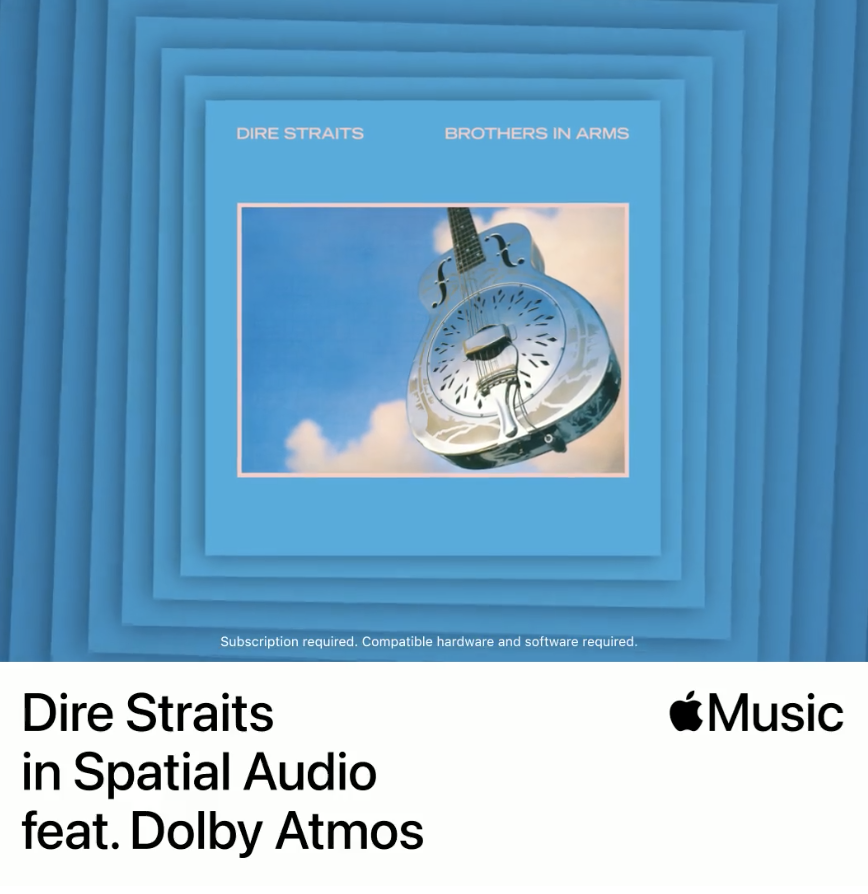
Money For Nothing covers the band’s output up through 1988, though obviously there’s one more studio album that came after–1991’s On Every Street, which you played on. Have there been any discussions about remixing that record in Atmos? I know it’s high on a lot of fans’ wishlists.
Absolutely. I've been gearing up to do it, just waiting for the green light from the label. If they’re able to put together the budget, I’m sure it’ll happen eventually.
You also did the Atmos mix of Mark’s new album, One Deep River, which was recently released on Blu-Ray disc as well as streaming. How did this project differ from the vintage Dire Straits remixes? Were you thinking about Atmos implementation during the recording process?
It wasn’t planned, but I did have it in the back of my mind–since we started working on the album right around the time Atmos was coming in over the horizon. Mark didn’t become a fan of the format until quite recently though, so he wasn’t really thinking about it.
Even if we were recording with Atmos in mind, I’m not sure I would’ve done all that much differently. It makes sense to stick up a few more ambient mics, but we were doing that anyway.
So when it came time to do the Atmos mix, did you just make stems from the stereo session?
No, I think using stems for Atmos is a bad idea. It’s an inhibitor, because you’re limited in what you can achieve in terms of both separation and dynamics.

That said, one project that put stems to good use was the "Going Home" single–but not for the final mix, only to send in-progress versions to each player so they could record their parts.
I wanted to ask about the making of that track. Did each player perform the song all the way through, and then you had to pick-and-choose which parts made the final cut?
I wanted to give each player complete freedom to contribute whatever they wanted, but as the track grew I had to make decisions in terms of what to include or it would get too crowded. So I’d have to take out a bit of Hank Marvin to put in a bit of Joe Bonamassa, and get rid of some crazily beautiful licks from people like Clapton and Townshend in order to make space.
No matter who’s playing on it, you’ve still got to stick to your rules. If it's too crowded, it's going to be horrible to listen to. It really became quite tricky in terms of managing the audio jigsaw puzzle, but I had two-and-a-half-years to put it together. There are 52 different mixes, because I’d have to edit and tweak it every time a new part was added. If I'd left it as a big pile of unmixing guitar parts until the last minute, I'd never have finished. [laughs]

I was going to say, you must have been in an impossible position when it came to choosing which parts to use. It’s like “well, I guess I’ve got to turn down Jeff Beck in this spot in order to fit in what David Gilmour’s doing.” [laughs]
Yeah, I had to make some really tough decisions along the way. Jeff Beck’s contribution was spine-chilling, and so sad given that he passed away not long after. It was Duane Eddy’s last performance as well.
I think what each player brought to the piece couldn't have been better. I just chose the things that felt like their signature sound. Like if David Gilmour played a lick that sounded like classic Gilmour, that was going in. I just kept looking out for things that really sounded like them.
Looking at the ADM master through the Dolby Atmos Renderer, I noticed you used nearly all 128 object channels–which is practically unheard of for a music mix.
Yeah, I’ve actually got a list of all the objects and who’s assigned to them. I think there are three or four players sharing each individual object.
When mixing in Atmos, do you normally only use objects or do you assign elements to the bed as well?
I do use one standard bed in order to send information to the LFE, but everything else is on objects. I don't really miss having to use bus compression or limiting, which you can do with beds. There are other ways to achieve what I'm trying to recreate with the stereo, and it's lovely to retain more of the dynamic range. That’s one of the great things about Atmos, and it suits Mark’s music so well.
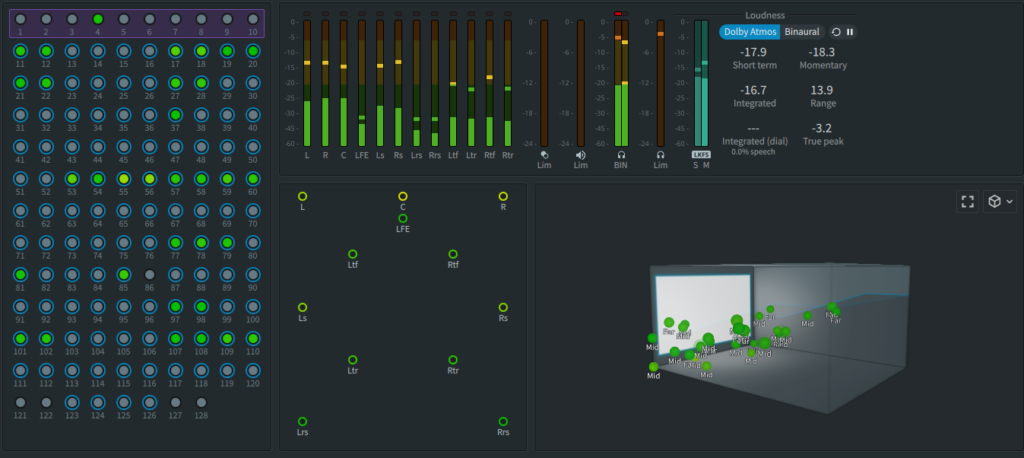
I’ve noticed that a signature feature of your Atmos mixes is heavy use of the front height speakers, usually to lift elements like the drum kit or lead vocal. So when the drums first kick in during a song like “Down To The Waterline,” you get this massive wall of sound.
Yeah, it’s a great way to extend the stereo picture. If you start pulling things out, particularly effects, you start to lose focus very quickly. One thing I learned quickly is to keep the main instruments and vocal focused upfront. If you mess around with those too much, the mix starts to fall apart.
With Mark’s music in particular, he’s not big on distractions–it’s all about the song. He really loved the stereo mixes of One Deep River, and was afraid that expanding out to Atmos might ruin the experience. In the end, he actually came to prefer the Atmos mixes to the stereo–which is fantastic. It really helps open things up.
Your most recent solo record, 2022’s Anomaly, is also out with an Atmos mix. I wanted to bring this to fans’ attention as it’s a bit of an under-the-radar release and the music is fantastic. I’m particularly fond of the opening track “Shagpile Bed,” which is kind of a great ode to the life of an assistant engineer or studio intern.
Thank you! I definitely wrote that song with people working in our industry in mind, hoping they might relate to the lyrics.

I’d love to hear about your involvement with Airsound’s new spatial technology. Is it really possible to create the perception of a 7.1.4 system using only two speakers? How does it compare with similar Atmos speaker systems currently out, such as Sonos’ ERA-300 and ARC soundbar?
Airsound is based around a concept called dipole steering, whereas other systems like the ERA-300 instead use discrete loudspeakers. So those speakers can’t steer sound, they only project it. With Airsound, because of the dipole steering technology you can use different combinations of speakers anywhere in the room. You might think that seems impossible, but it really works and it’s quite astounding to hear.
The original goal for Airsound was to create the impression of stereo from a single source. I remember when my Dad first demonstrated it to me way back in 2005: he had three loudspeakers on his mantlepiece, spread very far apart. He played me loads of music that sounded like wide stereo, but then he took the two loudspeakers that were on the sides down. It turned out those speakers on the sides weren’t actually doing anything, all the sound was being projected out from the one in the middle.
When Dolby Atmos came around two or three years ago now, I asked my brother Dan to investigate if it was possible to mix in the immersive format using the Airsound technology. After about six months of research, he demoed it for me in my Dad's living room with a couple of little speakers. He played me the Atmos mix of Brothers In Arms that I had just finished and it was unbelievable. I knew where some of the instruments were positioned, and they were coming from those spots even though there was no speaker there.
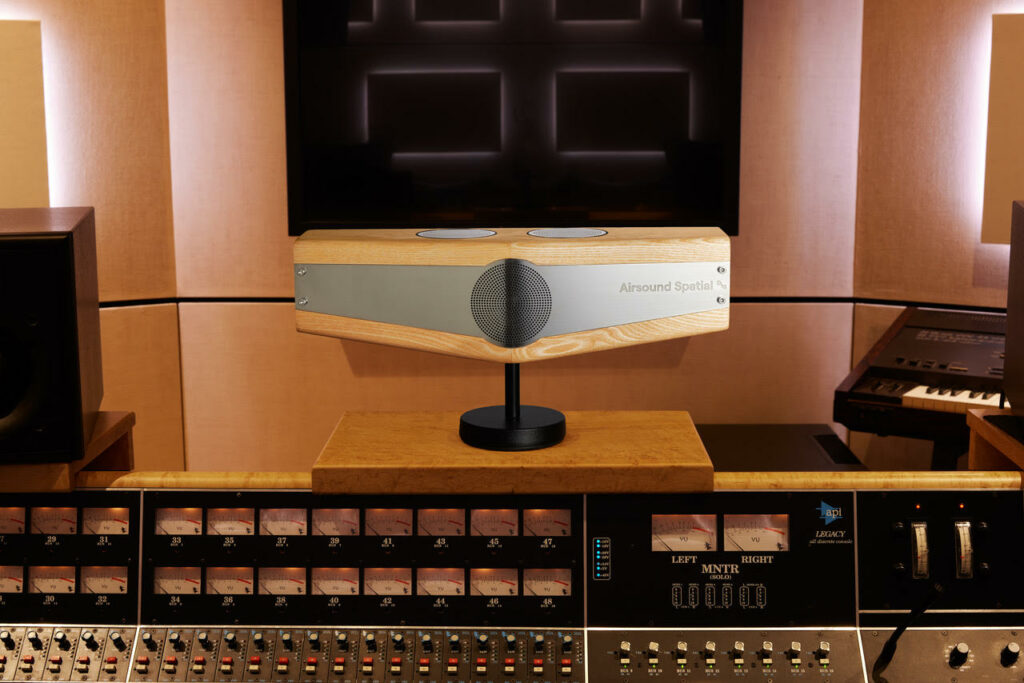
Even mixing with just two speakers, you can solo a guitar part and then have it move around the room seamlessly. In fact, the Guitar Heroes Atmos mix was created using just two Airsound speakers. I didn’t mix it at British Grove. To me, that proved it works on a professional level–nevermind the consumer level.
So what would a three-speaker configuration look like? Two in front, then a mono rear?
It doesn’t matter, it’s completely up to you. All you need to do is open the software app it comes with, then tell it how many speakers you’re using and how far apart they are.
I've used one in front and one behind, which sounds great, but my favorite setup uses four speakers: one up front, one behind, then the other two on the left and right sides.
It seems like most listeners are hearing Atmos mixes in binaural, which is so frustrating because we know how incredible the experience is with speakers. At the same time, I understand that most consumers aren’t going to invest in a 10 or 12-channel home theater system. So it sounds like the Airsound system could be the perfect way to bring the multichannel speaker experience into listeners’ homes at lower cost and without complications.
I completely agree. I have a pair of AirPods Max and they sound lovely, but overall I find listening in binaural isn’t very satisfying. It only really works when you have the visual component, when you’re looking at the renderer and can see where all the objects are placed.
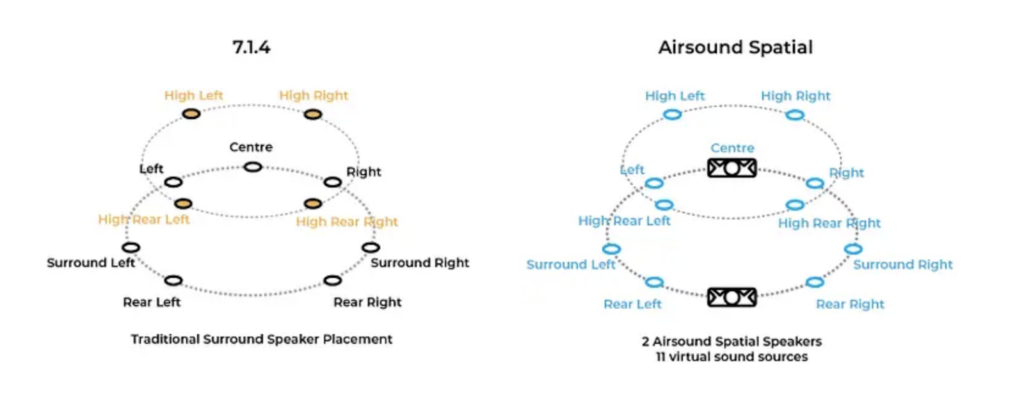
To me, Airsound is a game-changer because it basically allows consumers to get the full Atmos experience using just two speakers and a sub. We’ve still at the very early stage, though we’ve given demonstrations using the prototypes and blown away a lot of professionals. I’ve had some engineer friends call it witchcraft [laughs]. They all say the same thing: when can we get some? The answer on the professional level is quite soon, maybe a few months from now.
Once those are out, we’ll start doing some PR and getting the word out in the professional world. The idea is then to license the technology, and we’ve already had a lot of interest from a couple of big manufacturers. So we're incredibly excited about it.
We're going to plan a trip to America, probably later this year, where we'll go to the West Coast, and almost certainly come to New York. When we do that, you should definitely come by.
If you could remix any older record in Atmos, which would you choose?
I’d probably choose Can’t Buy A Thrill (1972) by Steely Dan. I don’t know if it’s been done in Atmos yet, but it seems like there’s so much to work with there in terms of multitracks. When I was 14 years old, I learned to play bass by listening to that album. So I know those songs inside-out.
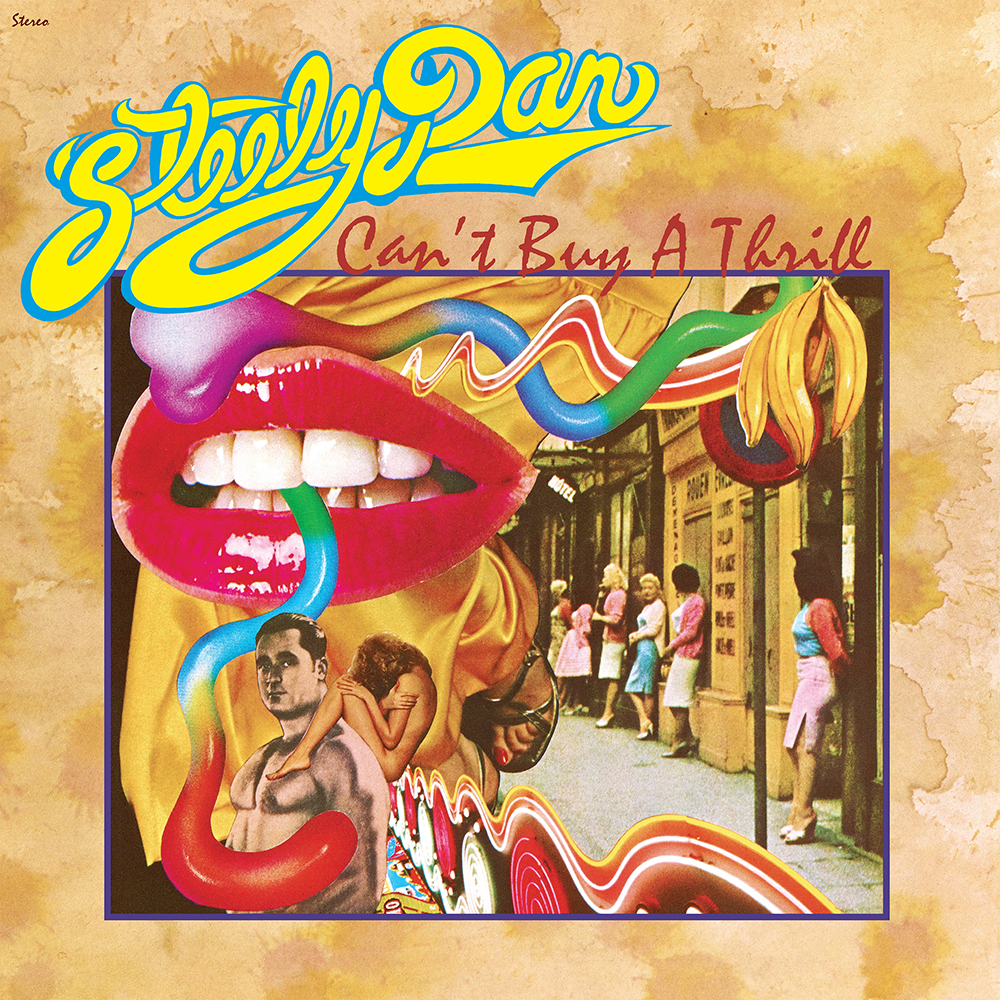
In 2006, Sound-On-Sound covered the making of “Money For Nothing” in their long-running Classic Tracks series of print articles. When interviewed, Neil Dorfsman mentioned that you were the inspiration for the famous synth intro with the big drums that leads into Mark’s famous guitar riff. Is it true that you came up with the idea for that?
Yeah, pretty much. I remember we were working on that track and Mark had kind of lost interest in it. Neil and I were playing around in the studio one night, and I came up with this sound on the mighty Yamaha DX-1 that sounded like a dinosaur or something. When Mark heard that sound the next morning, he was suddenly reinvigorated and re-energized. That’s when he got his Les Paul out and played the lick with the stationary wire pedal. From that point on, the track started to really happen.
Can you tease any upcoming immersive projects you’re involved with? I think you mentioned earlier that more of the Dire Straits catalog could be forthcoming.
Yeah, I'm geared up to work on some more Dire Straits. Obviously, I'd love to do the entire catalog. I’d also like to do Mark’s last album, Down The Road Wherever (2018).
Right now I’m working on an album for a friend of mine, who’s in a band called Our Man In The Field. So I’ll be mixing that in Atmos too.
With the vintage Dire Straits stuff, it’s great being able to reinvent something that’s so beloved by fans and have them hear it in a different way. My big aim is to really push this new format forward however best I can.
Purchase Going Home (Theme From Local Hero) in the IAA Shop!
Purchase Anomaly and High Roads in the IAA Shop!

